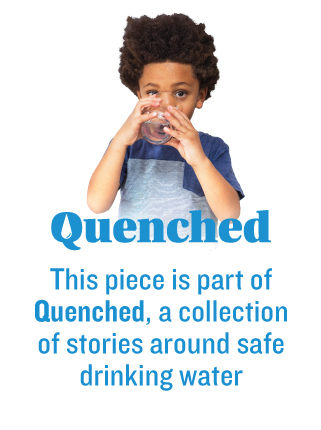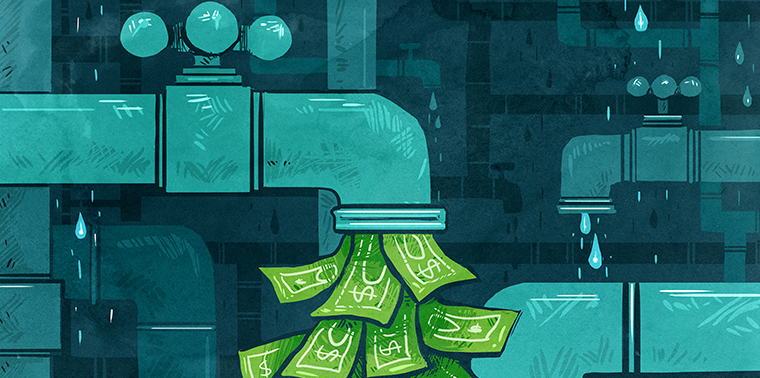April 17, 2017 —  Ask someone in Flint, Michigan, or São Paolo, Brazil — the list of cities rocked by water disasters seems to grow each day — how much safe clean water is worth. Worried about contamination and drought, it might be a pretty penny. But the ability of people to actually pay for the full cost of water — from protecting it at its source to getting it to flow from the tap — depends, as it does with anything for sale, on income. And yet water isn’t simply a commodity; it’s necessary for life, so the ethics and practicalities of how society pays for clean water quickly become tricky. The truth is that our growing income inequality means growing thirst and disease.
Ask someone in Flint, Michigan, or São Paolo, Brazil — the list of cities rocked by water disasters seems to grow each day — how much safe clean water is worth. Worried about contamination and drought, it might be a pretty penny. But the ability of people to actually pay for the full cost of water — from protecting it at its source to getting it to flow from the tap — depends, as it does with anything for sale, on income. And yet water isn’t simply a commodity; it’s necessary for life, so the ethics and practicalities of how society pays for clean water quickly become tricky. The truth is that our growing income inequality means growing thirst and disease.
Treating and delivering water and sanitizing effluent is not cheap, and the cost of providing safe drinking water continues to climb, fueled dramatically by crumbling infrastructure, unpredictable weather and the need to reach deeper into watersheds for safe water. Daily management and regulatory failures are also to blame. In Flint, a change of water sources caused lead to leach into drinking water. In Atlanta, where services had been privatized, quality spiraled downward, leading eventually to the city’s decision to re-municipalize water services.
Meanwhile, in the U.S. — and all over the world — public money for water services has been drying up. Policy-makers and water utility managers are increasingly reaching into constituents’ and customers’ wallets to cover increasing costs. While such a “full-cost recovery” philosophy seems to make sense in theory based on simple arithmetic — a utility should recover all costs associated with operations — and would seem to ensure fiscal discipline as it encourages conservation (i.e., when customers pay real water costs, they use less), the practice doesn’t take into account the fact that the U.N. General Assembly has said affordable water is a human right. Countries such as Ecuador and South Africa have even enshrined the right in their constitutions — although implementation has been spotty.
With water costs rising, inequality threatens to do the same.
In the U.S., the reality is a long way from such humanitarian declarations. PBS reports that between 2010 and 2015, water bills rose by 41 percent in 30 U.S. cities, and in 2014, water was too expensive for almost 12 percent of American households — about 14 million. In Detroit, some families fear child protective agencies may remove kids from homes where shut-offs have occurred.
With water costs rising, inequality threatens water access for everyone. Current trends are leaving the poor to drift. What follows are some potential solutions to keeping water affordable and available to everyone.
Metering Education?
When thinking about water affordability, we could consider how we pay for public education.
The U.S. seems to recognize the value for the common good of educating each of its citizens. We don’t expect each public school to recover all costs per student from each family. Costs are generally spread across a town, state and national tax base in at least a somewhat progressive fashion; even people without children pay into the system.
Likewise, it should be well understood that accessible, clean water is a public good that translates into public health and reduced health care costs for all. Of course, unlike education, water consumption can be measured with a meter. But just because water use can be measured doesn’t mean that each household should have to pay its water tab alone. We could follow the example of education and guarantee adequate water no matter the families’ circumstance.
We have tools at our disposal to ease the financial burden. We can, for example, use cross-subsidies so rates of wealthier users can guarantee access for poorer consumers, issue municipal water stamps (akin to food stamps), put water pollution fines into an affordability fund, and pay for water source protection through the U.S. Department of Agriculture budget. Cost-sharing possibilities — some elaborated below — are nearly endless. All could chip away at what low-income families would have to pay out of pocket.
The Carrot and the Stick
The U.N.’s Food and Agriculture Organization reports that globally 69 percent of water is used for agriculture, 19 percent for industry, and 12 percent for households and businesses. In the U.S., energy producers use just shy of 50 percent of our nation’s water, followed by irrigators. Households use about 1 percent.
Watershed degradation hits all users hard, but it’s water utilities that experience a disproportionate increase in treatment costs. It is they who put conservation programs in place and scramble to shore up an increasingly erratic water supply. While it’s good news that water utilities are paying more attention to protecting source water and watersheds — they’re the ones ultimately in the hot seat for ensuring safe water — it can’t be their job alone, and it’s unfair to their customers to carry all associated costs.
A mix of carrots and sticks can stop pollution and finance watershed protection.
In one instance, seeking a solution to rising treatment costs, the Des Moines, Iowa, water utility unsuccessfully sued upstream farming counties for overloading streams with nitrates from fertilizers. While lawsuits constitute one approach, there are other ways forward that don’t involve the courts. Perhaps the best known case of transforming conflict into cooperation — and a pioneering example of payment for environmental services — is New York City’s win-win agreement with upstream farmers. In that case, to avoid building a US$6 billion treatment plant, the New York City water utility has invested in source water protection measures more than 100 miles (160 kilometers) away, such as on-farm improvements that divert cow manure from drinking water sources. A mix of carrots and sticks can stop pollution and finance watershed protection, and such measures can shave a portion off household water bills while conserving water.
Federal Help? Maybe, but Try Cities and States
Since 1977, federal spending for water infrastructure has shrunk 82 percent per capita. Federal grants have diminished and largely been replaced by loans. State and local governments are hard-pressed to come up with funds to keep water systems in good repair. Loan interest adds to consumers’ water bills.
It seems unlikely that President Trump will approve public dollars for public water utilities within his infrastructure plan, even though simple zero-interest loans for pipes and sewage plants could mean significant cost savings for utilities and their customers. Nevertheless, there is movement in Congress. A new water bill was recently introduced — The Water Affordability, Transparency, Equity and Reliability (WATER) Act — to make US$35 billion a year available for improved drinking water and sanitation.
States and cities may very well go broke making up for the hoped-for federal support, and yet, acutely aware of the consequences for their constituents if they don’t act swiftly, many have shored up deficient water systems, issuing almost US$38 billion in municipal bonds for infrastructure projects related to water and sanitation in 2016. In 2014, California voters approved a US$7.5 billion water infrastructure bond. Paying back these bonds will certainly burden taxpayers, but depending on how bond repayments are structured, the costs can be spread broadly through state and municipal taxes and fees.
The much predicted water wars are no longer on some far-off horizon; they stare us square in the eye, raising questions about our moral fiber and the quality of our democracy.
Vigorously Mix Water and Politics
Keeping water in the public eye is essential to solve our water issues. Standing Rock — where protestors gained international attention for the Standing Rock Sioux Tribe arguing an oil pipeline would jeopardize its drinking water — is perhaps the best known recent case, but there are local efforts underway across the U.S. to make sure that water quality isn’t compromised by things such as pipelines and fracking. In cities across the country, citizens call for the need to keep water services public and affordable. When the League of Women Voters in Twin Peaks, California, holds a public forum on Nestlé’s water extraction, public pressure in one place can inform strategies in another. Increasingly, water has become a topic that candidates running for office must address.
Water War Truce
The much predicted water wars are no longer on some far-off horizon; they stare us square in the eye, raising questions about our moral fiber and the quality of our democracy. To whom will our diminishing supply of clean water flow? As we invest in our public water systems — and we must — let’s remember to distribute costs equitably and not let rising water rates further exacerbate inequality. Resolving the water crisis on the backs of the poor is no solution at all. The hopeful progress being made in some states to raise the minimum wage will become diluted if income gains flow out in the next water bill. Sharing source water protection costs; capitalizing municipal, state and federal water infrastructure funds; and keeping water public and in the public eye are just a few of the many steps we can take to keep water affordable and inequality in check. ![]()
Editor’s note: The views expressed here are those of the author and not necessarily of Ensia.
Ensia shares solutions-focused stories free of charge through our online magazine and partner media. That means audiences around the world have ready access to stories that can — and do — help them shape a better future. If you value our work, please show your support today.
Yes, I'll support Ensia!
